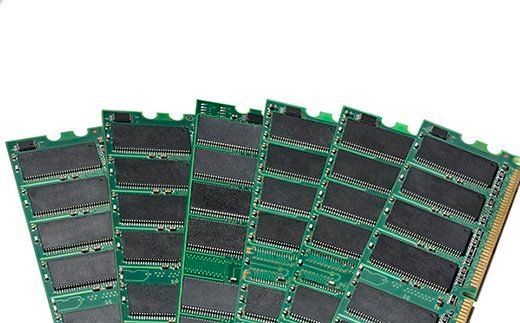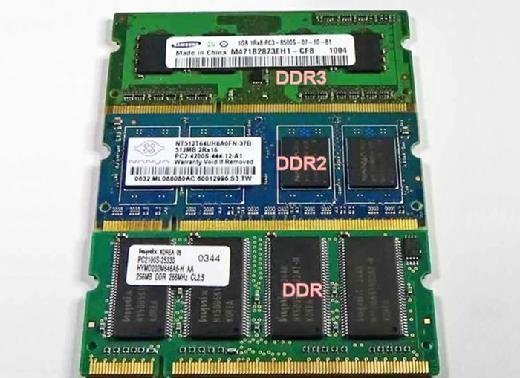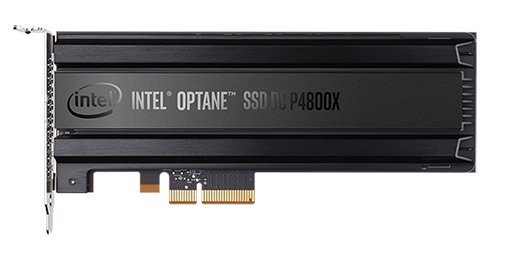What Is the Use of Read Enable in Memory
What is RAM?
RAM (Random Access Retentiveness) is the hardware in a calculating device where the operating arrangement (OS), awarding programs and information in current use are kept so they can be speedily reached by the device's processor. RAM is the primary retention in a computer. Information technology is much faster to read from and write to than other kinds of storage, such every bit a hd drive (HDD), solid-country bulldoze (SSD) or optical drive.
Random Admission Retention is volatile. That means data is retained in RAM as long as the computer is on, only it is lost when the figurer is turned off. When the computer is rebooted, the Os and other files are reloaded into RAM, unremarkably from an HDD or SSD.
Office of RAM
Because of its volatility, RAM can't shop permanent data. RAM can be compared to a person'southward short-term retention, and a hd drive to a person's long-term memory. Short-term memory is focused on immediate work, but it can only go along a limited number of facts in view at any i time. When a person's short-term memory fills up, it tin be refreshed with facts stored in the brain's long-term retentiveness.
A computer also works this way. If RAM fills up, the computer's processor must repeatedly go to the hard disk drive to overlay the old information in RAM with new data. This procedure slows the estimator's operation.

A computer'due south hd can become completely total of information and unable to take whatsoever more, just RAM won't run out of memory. However, the combination of RAM and storage memory tin be completely used upwardly.
How does RAM piece of work?
The termrandom admission as applied to RAM comes from the fact that any storage location, likewise known as any retention address, can be accessed directly. Originally, the termRandom Admission Retentivity was used to distinguish regular core retentivity from offline memory.
Offline memory typically referred to magnetic record from which a specific piece of data could only be accessed past locating the address sequentially, starting at the beginning of the tape. RAM is organized and controlled in a fashion that enables information to be stored and retrieved directly to and from specific locations.
Other types of storage -- such as the hard drive and CD-ROM-- are also accessed directly or randomly, but the termrandom admission isn't used to draw these other types of storage.
RAM is similar in concept to a set of boxes in which each box tin concur a 0 or a 1. Each box has a unique address that is found past counting across the columns and downwardly the rows. A set of RAM boxes is called an array, and each box is known as a prison cell.
To find a specific prison cell, the RAM controller sends the column and row address downward a sparse electrical line etched into the chip. Each row and column in a RAM assortment has its ain accost line. Any data that'south read flows back on a split data line.
RAM is physically small and stored in microchips. It's also small in terms of the amount of data information technology can agree. A typical laptop reckoner may come with 8 gigabytes of RAM, while a hard disk can hold 10 terabytes.
A hard drive, on the other hand, stores information on the magnetized surface of what looks similar a vinyl tape. Alternatively, an SSD stores data in memory fries that, unlike RAM, are nonvolatile. They don't depend on having constant power and won't lose data in one case the ability is turned off. RAM microchips are gathered together into memory modules. These plug into slots in a computer's motherboard. A bus, or a gear up of electric paths, is used to connect the motherboard slots to the processor.
Most PCs enable users to add RAM modules upward to a certain limit. Having more than RAM in a computer cuts down on the number of times the processor must read data from the hard disk drive, an operation that takes longer than reading information from RAM. RAM access time is in nanoseconds, while storage memory access fourth dimension is in milliseconds.
How much RAM do y'all need?
The amount of RAM needed all depends on what the user is doing. When video editing, for example, information technology's recommended that a arrangement take at to the lowest degree 16 GB RAM, though more is desirable. For photo editing using Photoshop, Adobe recommends a arrangement have at least 3GB of RAM to run Photoshop CC on a Mac. However, if the user is working with other applications at the same time, even 8GB of RAM tin can slow things down.
Types of RAM
RAM comes in two chief forms:
- Dynamic Random Admission Memory ( DRAM ) makes up the typical calculating device'south RAM, and as was previously noted, it needs that power to be on to retain stored data.
Each DRAM prison cell has a charge or lack of charge held in an electrical capacitor. This data must exist constantly refreshed with an electronic charge every few milliseconds to recoup for leaks from the capacitator. A transistor serves as a gate, determining whether a capacitor'due south value tin exist read or written.
- Static Random Access Retentiveness ( SRAM ) also needs constant ability to hold on to data, but it doesn't need to be continually refreshed the mode DRAM does.
In SRAM, instead of a capacitor holding the charge, the transistor acts as a switch, with one position serving equally ane and the other position every bit 0. Static RAM requires several transistors to retain one bit of data compared to dynamic RAM which needs only 1 transistor per bit. As a result, SRAM chips are much larger and more expensive than an equivalent amount of DRAM.
However, SRAM is significantly faster and uses less power than DRAM. The price and speed differences mean static RAM is mainly used in small amounts as enshroud memory inside a computer's processor.

History of RAM: RAM vs. SDRAM
RAM was originally asynchronous because the RAM microchips had a different clock speed than the reckoner'due south processor. This was a problem every bit processors became more powerful and RAM couldn't keep up with the processor's requests for data.
In the early 1990s, clock speeds were synchronized with the introduction of synchronous dynamic RAM, or SDRAM. By synchronizing a computer's retention with the inputs from the processor, computers were able to execute tasks faster.
However, the original unmarried data rate SDRAM (SDR SDRAM) reached its limit quickly. Around the twelvemonth 2000, double data rate synchronous Random Access Memory (DDR SRAM) was developed. This moved information twice in a unmarried clock cycle, at the offset and the end.
DDR SDRAM has evolved iii times, with DDR2, DDR3 and DDR4, and each iteration has brought improved data throughput speeds and reduced power utilize. However, each DDR version has been incompatible with before ones because, with each iteration, information is handled in larger batches.

GDDR SDRAM
Graphics double information rate (GDDR) SDRAM is used in graphics and video cards. Similar DDR SDRAM, the technology enables information to be moved at various points in a CPU clock cycle. Nonetheless, information technology runs at higher voltages and has less strict timing than DDR SDRAM.
With parallel tasks, such as 2D and 3D video rendering, tight access times aren't as necessary, and GDDR tin enable the college speeds and retentivity bandwidth needed for GPU operation.
Like to DDR, GDDR has gone through several generations of evolution, with each providing more functioning and lower ability consumption. GDDR6 is the latest generation of graphics memory.
RAM vs. virtual memory
A computer tin run short on retentivity, peculiarly when running multiple programs simultaneously. Operating systems tin recoup for concrete retentiveness shortfalls by creating virtual memory.
With virtual retention, data is temporarily transferred from RAM to disk storage, and virtual address infinite is increased using agile memory in RAM and inactive memory in an HDD to class contiguous addresses that agree an application and its data. Using virtual memory, a system can load larger programs or multiple programs running at the aforementioned fourth dimension, letting each operate as if it has infinite memory without having to add more RAM.
Virtual retention is able to handle twice as many addresses equally RAM. A program's instructions and information are initially stored at virtual addresses, and in one case the program is executed, those addresses are turned into bodily memory addresses.
One downside to virtual retentiveness is that it can slow a calculator because information must exist mapped between the virtual and concrete retentiveness. With concrete memory alone, programs piece of work direct from RAM.
RAM vs. flash memory
Flash retentivity and RAM are both comprised of solid-state chips. However, they play different roles in computer systems because of differences in the style they're made, their functioning specifications and cost. Flash memory is used for storage memory. RAM is used every bit active memory that performs calculations on the information retrieved from storage.
One meaning difference between RAM and flash memory is that data must exist erased from NAND flash memory in entire blocks. This makes information technology slower than RAM, where information can be erased in individual bits.
However, NAND flash memory is less expensive than RAM, and it's also nonvolatile. Different RAM, it tin can hold information even when the power is off. Because of its slower speed, nonvolatility and lower cost, wink is often used for storage memory in SSDs.
RAM vs. ROM
Read-merely retention, or ROM, is computer memory containing data that can only be read, not written to. ROM contains boot-up programming that is used each time a computer is turned on. Information technology more often than not can't exist contradistinct or reprogrammed.
The information in ROM is nonvolatile and isn't lost when the computer power is turned off. As a result, read-simply memory is used for permanent information storage. Random Access Memory, on the other hand, can simply hold data temporarily. ROM is generally several megabytes of storage, while RAM is several gigabytes.
Trends and futurity directions
Resistive Random Access Retentivity (RRAM or ReRAM) is nonvolatile storage that can alter the resistance of the solid dielectric fabric it's equanimous of. ReRAM devices contain a memristor in which the resistance varies when dissimilar voltages are applied.
ReRAM creates oxygen vacancies, which are concrete defects in a layer of oxide material. These vacancies represent ii values in a binary arrangement, similar to a semiconductor'south electrons and holes.
ReRAM has a college switching speed compared to other nonvolatile storage technologies, such equally NAND wink. It as well holds the promise of high storage density and less ability consumption than NAND flash. This makes ReRAM a skilful option for retentivity in sensors used for industrial, automotive and net of things applications.
Vendors take struggled for years to develop ReRAM engineering science and get chips into product. A few vendors are currently shipping them.
3D XPoint technology, such as Intel's Optane, could somewhen make full the gap between dynamic RAM and NAND flash memory. 3D XPoint has a transistor-less, cantankerous-signal compages in which selectors and retention cells are at the intersection of perpendicular wires. 3D XPoint isn't as fast as DRAM, but it is nonvolatile memory.

In terms of performance and price, 3D XPoint technology is between fast, only costly DRAM and slower, less expensive NAND flash. Every bit the engineering develops, it may mistiness the distinction between RAM and storage.
5G and the RAM market
In February 2019, the JEDEC Solid State Technology Association published the JESD209-five, Low Ability Double Information Rate five (LPDDR5). LPDDR5 volition eventually operate at an I/O rate of 6400 MT/s, 50 per centum college than that of the outset version of LPDDR4. This will significantly boost retentiveness speed and efficiency for a variety of applications. This includes mobile computing devices such every bit smartphones, tablets and ultra-sparse notebooks.
LPDDR5 was published with a data charge per unit of 6400 MT/southward, compared to 3200 MT/southward for LPDDR4 at its publication in 2014.
In July 2019, Samsung Electronics began mass producing the industry's first 12-gigabit LPDDR5 mobile DRAM. According to Samsung, it has been optimized for enabling 5G and AI features in future smartphones.
Cost of RAM
Past the summer of 2019, DRAM prices remained depressed from earlier levels -- but volatile, nonetheless. A number of variables contributed to the volatility, including:
- a supply glut
- market tensions between Republic of korea and Nippon (home to the world's two largest memory scrap makers, Samsung and SK Hynix)
- the introduction of the adjacent-generation mobile chip, the LPDDR5
- the increased adoption of 5G applied science
- an anticipated increase in need for consumer electronics in the Internet of Things (IoT), such as automobiles and wear devices, which apply the chips
Source: https://www.techtarget.com/searchstorage/definition/RAM-random-access-memory
0 Response to "What Is the Use of Read Enable in Memory"
Post a Comment